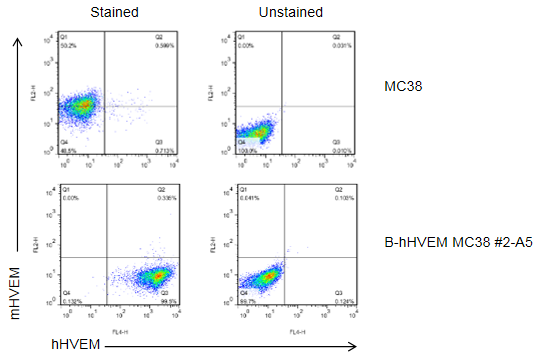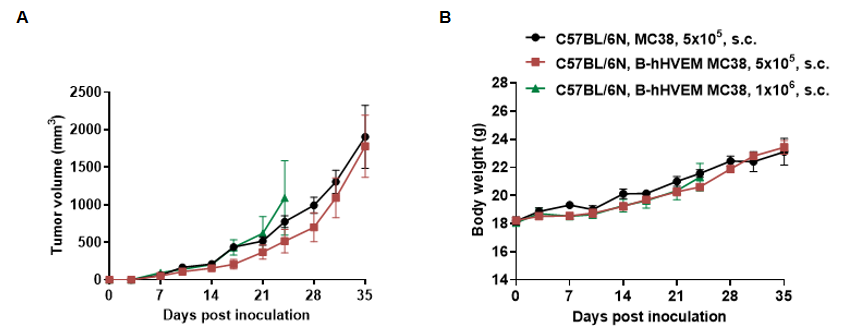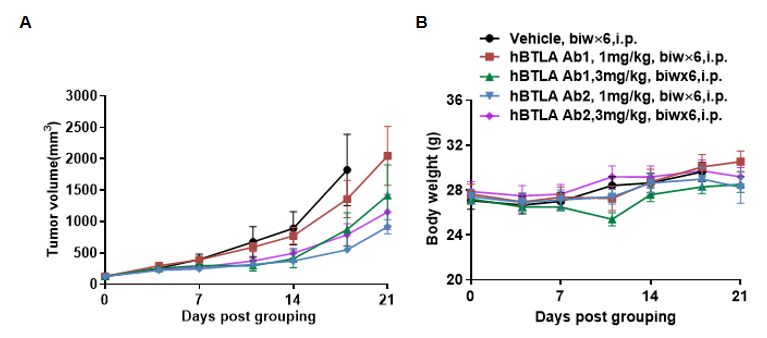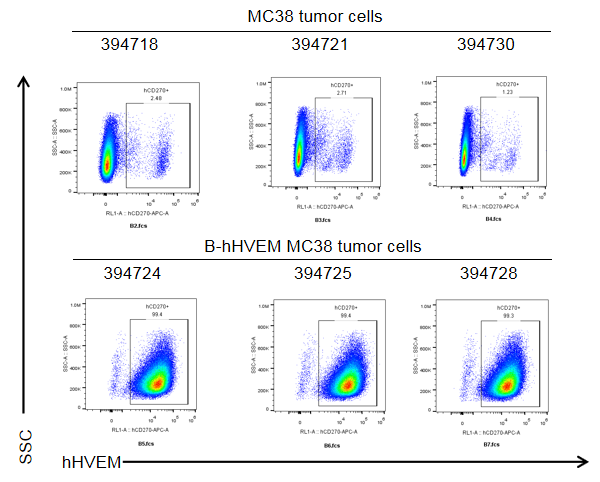Common name
|
B-hHVEM MC38
|
Catalog number
|
310693
|
|
Aliases
|
TNFRSF14, CD270
|
Disease
|
Colon carcinoma
|
Organism
|
Mouse
|
Strain
|
C57BL/6
|
|
Tissue types
|
Colon
|
Tissue
|
Colon
|
Description
The mouse Hvem gene was replaced by human HVEM coding sequence in B-hHVEM MC38 cells. Human HVEM is highly expressed on the surface of B-hHVEM MC38 cells.
Application
B-hHVEM MC38 cells have the capability to establish tumors
in vivo and can be used for efficacy studies.
Targeting strategy
Gene targeting strategy for B-hHVEM MC38 cells. The exogenous promoter and human HVEM coding sequence was inserted to replace part of murine exon 3 and all of exon 4. The insertion disrupts the endogenous murine Hvem gene, resulting in a non-functional transcript.
Protein expression analysis

HVEM expression analysis in B-hHVEM MC38 cells by flow cytometry. Single cell suspensions from wild-type MC38 and B-hHVEM MC38 cultures were stained with species-specific anti-HVEM antibody. Mouse HVEM was detectable in wild-type MC38 cells. Human HVEM was detected on the surface of B-hHVEM MC38 cells but not wild-type MC38 cells. The 2-A5 clone of B-hHVEM MC38 cells was used for in vivo experiments.
Tumor growth curve & Body weight changes

Subcutaneous homograft tumor growth of B-hHVEM MC38 cells. B-hHVEM MC38 cells (5x105 and 1x106) and wild-type MC38 cells (5x105) were subcutaneously implanted into C57BL/6N mice (female, 5-8-week-old, n=5). Tumor volume and body weight were measured twice a week. (A) Average tumor volume ± SEM. (B) Body weight (Mean± SEM). Volume was expressed in mm3 using the formula: V=0.5 X long diameter X short diameter2. As shown in panel A, B-hHVEM MC38 cells were able to establish tumors in vivo and can be used for efficacy studies.
In vivo efficacy of anti human BTLA antibodies

Antitumor activity of anti-human BTLA antibodies in B-hBTLA mice. (A) Anti human BTLA antibodies inhibited B-hHVEM MC38 tumor growth in B-hBTLA mice. Murine colon cancer B-hHVEM MC38 cells were subcutaneously implanted into homozygous B-hBTLA mice (male, 6-week-old, n=5). Mice were grouped when tumor volume reached approximately 100 mm3, at which time they were treated with two anti-human BTLA antibodies with doses and schedules indicated in panel. (B) Body weight changes during treatment. As shown in panel A, As shown in panel A, B-hHVEM MC38 were able to establish tumor in vivo and can be used for efficacy study. Values are expressed as mean ± SEM
Tumor growth curve & Body weight changes

Subcutaneous homograft tumor growth of B-hHVEM MC38 cells. B-hHVEM MC38 cells (1x106) and wild-type MC38 cells (5x105) were subcutaneously implanted into homozygous B-hBTLA/hHVEM mice (female, 6-week-old, n=7). Tumor volume and body weight were measured twice a week. (A) Average tumor volume ± SEM. (B) Body weight (Mean ± SEM). Volume was expressed in mm3 using the formula: V=0.5 X long diameter X short diameter2. As shown in panel A, B-hHVEM MC38 cells were able to form tumors in vivo and can be used for efficacy studies.
Tumor growth curve of individual mice

B-hHVEM MC38 tumor cells growth of individual mice. B-hHVEM MC38 cells (1x106) and wild-type MC38 cells (5x105) were subcutaneously implanted into homozygous B-hBTLA/hHVEM mice (female, 6-week-old, n=7). As shown in panel, B-hHVEM MC38 cells were able to establish tumors in vivo and can be used for efficacy studies.
Protein expression analysis of tumor cells

B-hHVEM MC38 cells were subcutaneously transplanted into homozygous B-hBTLA/hHVEM mice (n=7), and on 28 days post inoculation, tumor cells were harvested and assessed for human HVEM expression by flow cytometry. As shown, human HVEM was highly expressed on the surface of tumor cells. Therefore, B-hHVEM MC38 cells can be used for in vivo efficacy studies of HVEM therapeutics.















